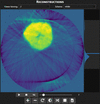issue contents
July 2024 issue

Cover illustration: Reconstructed 3D magnetic structure of a 5 µm-diameter pillar from a Nd2Fe14B single crystal using dichroic scanning hard X-ray nanotomography at the NanoMAX beamline at the MAX IV synchrotron radiation source (see Banerjee, Gürsoy, Deng, Kahnt, Kramer, Lynn, Haskel and Strempfer, pages 877–887).
facility information
editorial
 access
accessfeature articles
 access
accessPhotonMEADOW2023 workshop
 access
access access
accessThe beam shaping optics of synchrotrons and X-ray free-electron lasers are routinely measured using deflectometric profilometers, which use autocollimators to evaluate the surface slope from the displacement of a reticle image on a detector. Here, novel strategies to reduce systematic measurement errors by using a set of overlapping images of the reticle obtained at different positions on the detector, which can reduce the systematic errors by up to a factor of four to five without recourse to external measurements, are discussed.
 access
access access
access access
access access
access access
access access
accessx-ray spectroscopy for functional materials
 access
access access
accessresearch papers
 access
access access
access access
access access
access access
access access
access access
access access
access access
access access
access access
access access
access access
access access
access access
access access
access access
access access
access access
accessshort communications
 access
accessbeamlines
 access
access access
accesscomputer programs
 access
accessteaching and education
 access
accessnotes and news
 access
access
 journal menu
journal menu

























































